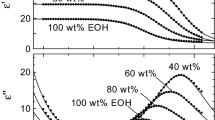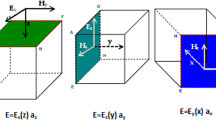Abstract
Dielectric measurements are one of the most reliable techniques for investigating the molecular dynamics of water in moist materials. However, dielectric measurements of moist wood have not yet been carried out in a wide frequency range that can be used to evaluate the molecular dynamics of water in wood. We performed dielectric measurements of a deciduous tree, Zelkova serrata, along the fiber direction in the frequency range of 40 Hz to 10 GHz at room temperature around the fiber saturation point of wood to investigate the molecular dynamics of water in wood. Cole–Cole-type relaxation process reflecting the molecular dynamics of the water is observed in the GHz region. The water content dependences of the relaxation time and strength of this process are similar to those of the relaxation process of free water observed in polymer–water mixtures. However, the τ − β CC diagram of this process markedly deviates from that of the relaxation process of free water in polymer–water mixtures. The molecular mechanism of this characteristic relaxation process is interpreted as the formation of the local structure of water restricted in the void spaces of wood. The water molecules adsorbed on the inner walls of the void spaces form a local structure, and the local structure grows in the length direction along the walls of the void spaces with increasing water content of wood. The molecular dynamics of these water molecules is strongly restricted between the inner walls of the void spaces and air spaces, and the strongly restricted molecular dynamics of the water leads to the characteristic relaxation process observed in the GHz region. We give molecular descriptions of the strongly restricted water adsorbed on the inner walls of the void spaces of wood around the fiber saturation point.







Similar content being viewed by others
References
Skaar C (1988) Wood-water relations. Springer, Berlin
Zelinka SL, Lambrecht MJ, Glass SV, Wiedenhoeft AC, Yelle DJ (2012) Examination of water phase transitions in Loblolly pine and cell wall components by differential scanning calorimetry. Thermochim Acta 533:39–45
Simpson W (1980) Sorption theories applied to wood. Wood Fiber Sci 12:183–195
Labbé N, Jéso BD, Lartigue JC, Daudé G, Pétraud M, Ratier M (2006) Time-domain 1H NMR characterization of the liquid phase in greenwood. Holzforschung 60:265–270
Telkki VV, Yliniemi M, Jokisaari J (2013) Moisture in softwoods: fiber saturation point, hydroxyl site content, and the amount of micropores as determined from NMR relaxation time distributions. Holzforschung 67:291–300
Yang SY, Eom CD, Han Y, Chang Y, Park Y, Lee JJ, Choi JW, Yeo H (2014) Near-Infrared spectroscopic analysis for classification of water molecules in wood by a theory of water mixtures. Wood Fiber Sci 46:138–147
Jinzhen C, Guangjie Z (2001) Dielectric relaxation based on adsorbed water in wood cell wall under non-equilibrium state 2. Holzforschung 55:87–92
Sugimoto H, Norimoto M (2004) Dielectric relaxation due to interfacial polarization for heat-treated wood. Carbon 42:211–218
Sugimoto H, Takazawa R, Norimoto M (2005) Dielectric relaxation due to heterogeneous structure in moist wood. J Wood Sci 51:549–553
Sugimoto H, Norimoto M (2005) Dielectric relaxation due to the heterogeneous structure of wood charcoal. J Wood Sci 51:554–558
Wang Y, Minato K, Iida I (2008) Mechanical properties of wood in an unstable state due to temperature changes, and analysis of the relevant mechanism VI: dielectric relaxation of quenched wood. J Wood Sci 54:16–21
Le BD, Strømme M, Mihranyan A (2015) Characterization of dielectric properties of nanocellulose from wood and algae for electrical insulator applications. J Phys Chem B 119:5911–5917
Rawat SPS, Khali DP (1998) Clustering of water molecules during adsorption of water in wood. J Polym Sci B 36:665–671
Runt JP, Fitzgerald JJ (1997) Dielectric spectroscopy of polymeric materials. American Chemical Society, New York
Kremer F, Schönhals A (2003) Broadband dielectric spectroscopy. Springer, Berlin
Jinzhen C, Guangjie Z (2002) Dielectric relaxation based on adsorbed water in wood cell wall under non-equilibrium state. Part 3: Desorption. Holzforschung 56:655–662
Sugiyama M, Norimoto M (2006) Dielectric relaxation of water adsorbed on chemically treated woods. Holzforschung 60:549–557
Sugimoto H, Kanayama K, Norimoto M (2007) Dielectric relaxation of water adsorbed on wood and charcoal. Holzforschung 61:89–94
Handa T, Fukuoka M, Yoshizawa S, Kanamoto T (1982) The effect of moisture on the dielectric relaxations in wood. J Appl Polym 27:439–453
Mai TC, Razafindratsima S, Sbartaï ZM, Demontoux F, Bos F (2015) Non-destructive evaluation of moisture content of wood material at GPR frequency. Constr Build Mater 77:213–217
Koubaa A, Perré P, Hutcheon RM, Lessard J (2008) Complex dielectric properties of the sapwood of aspen, white birch, yellow birch, and sugar maple. Dry Technol 26:568–578
Tomppo L, Tiitta M, Laakso T, Harju A, Venäläinen M, Lappalainen R (2009) Dielectric spectroscopy of scots pine. Wood Sci Technol 43:653–667
Jördens C, Wietzke S, Scheller M, Koch M (2010) Investigation of the water absorption in polyamide and wood plastic composite by terahertz time-domain spectroscopy. Polym Test 29:209–215
Bossou OV, Mosig JR, Zurcher JF (2010) Dielectric measurements of tropical wood. Measurement 43:400–405
Shinyashiki N, Sudo S, Abe W, Yagihara S (1998) Shape of dielectric relaxation curves of ethylene glycol oligomer-water mixtures. J Chem Phys 109:9843–9847
Shinyashiki N, Yagihara S, Arita I, Mashimo S (1998) Dynamics of water in a polymer matrix studied by a microwave dielectric measurement. J Phys Chem B 102:3249–3258
Shinyashiki N, Yagihara S (1999) Comparison of dielectric relaxations of water mixtures of poly(vinylpyrrolidone) and 1-vinyl-2-pyrrolodinone. J Phys Chem B 103:4481–4484
Yagihara S, Oyama M, Inoue A, Asano M, Sudo S, Shinyashiki N (2007) Dielectric relaxation measurement and analysis of restricted water structure in rice kernels. Meas Sci Technol 18:983–990
Hayashi Y, Shinyashiki N, Yagihara S (2002) Dynamical structure of water around biopolymers investigated by microwave dielectric measurements via time domain reflectometry. J Non Cryst Solids 305:328–332
Hayashi Y, Oshige I, Katsumoto Y, Omori S, Yasuda A (2007) Protein–solvent interaction in urea–water systems studied by dielectric spectroscopy. J Non Cryst Solids 353:4492–4496
Yagihara S, Miura N, Hayashi Y, Miyairi H, Asano M, Yamada G, Shinyashiki N, Mashimo S, Umehara T, Tokita M, Naito S, Nagahama T, Shiotsubo M (2001) Microwave dielectric study on water structure and physical properties of aqueous systems using time domain reflectometry with flat-end cells. Subsurf Sens Technol Appl 2:15–29
Yagihara S (2015) Nano/micro science and technology in biorheology: principles. In: Dobashi T, Kita R (eds) Methods, and applications. Springer, Tokyo, pp 183–213
Abe F, Nishi A, Saito H, Asano M, Watanabe S, Kita R, Shinyashiki N, Yagihara S, Fukuzaki M, Sudo S, Suzuki Y (2017) Dielectric study on hierarchical water structures restricted in cement and wood materials. Meas Sci Technol 28:044008–044017
Cole RH, Mashimo S, Winsor PJ IV (1980) Evaluation of dielectric behavior by time domain spectroscopy. 3. Precision difference methods. J Phys Chem 84:786–793
Mashimo S, Umehara T, Ota T, Kuwabara S, Shinyashiki N, Yagihara S (1987) Evaluation of complex permittivity of aqueous solution by time domain reflectometry. J Mol Liq 36:135–151
Norimoto M, Hayashi S, Yamada T (1978) Anisotropy of dielectric constant in coniferous wood. Holzforschung 32:167–172
Kabir MF, Daud WM, Khalid K, Sidek HAA (1998) Dielectric and ultrasonic properties of rubber wood. Effect of moisture content grain direction and frequency. Eur J Wood Wood Prod 56:223–227
Sahin H, Ay N (2004) Dielectric properties of hardwood species at microwave frequencies. J Wood Sci 50:375–380
Barthel J, Bachhuber K, Buchner R, Hetzenauer H (1990) Dielectric spectra of some common solvents in the microwave region. Water and lower alcohols. Chem Phys Lett 165:369–373
Schűller J, Meĺnichenko YB, Richert R, Fischer EW (1994) Dielectric studies of the glass transition in porous media. Phys Rev Lett 73:2224–2227
Schűller J, Richert R, Fischer EW (1995) Dielectric relaxation of liquids at the surface of a porous glass. Phys Rev B 52:15232–15238
Ryabov YE, Feldman Y, Shinyashiki N, Yagihara S (2002) The symmetric broadening of the water relaxation peak in polymer–water mixtures and its relationship to the hydrophilic and hydrophobic properties of polymers. J Chem Phys 116:8610–8615
Kundu SK, Yagihara S, Yoshida M, Shibayama M (2009) Microwave dielectric study of an oligomeric electrolyte gelator by time domain reflectometry. J Phys Chem B 113:10112–10116
Kundu SK, Okudaira S, Kosuge M, Shinyashiki N, Yagihara S (2009) Phase transition and abnormal behavior of a nematic liquid crystal in benzene. J Phys Chem B 113:11109–11114
Martin JE, Hurd AJ (1987) Scattering from fractals. J Appl Cryst 20:61–78
Nittmann J, Daccord G, Stanley HE (1985) Fractal growth of viscous fingers: quantitative characterization of a fluid instability phenomenon. Nature 314:141–144
Zhang SW (1998) State-of-the-art of polymer tribology. Tribol Int 31:49–60
Augé S, Schmit PO, Crutchfield CA, Islam MT, Harris DJ, Durand E, Clemancey M, Quoineaud AA, Lancelin JM, Prigent Y, Taulelle F, Delsuc MA (2009) NMR measure of translational diffusion and fractal dimension. Application to molecular mass measurement. J Phys Chem B 113:1914–1918
Takahashi A, Kita R, Shinozaki T, Kubota K, Kaibara M (2003) Real space observation of three-dimensional network structure of hydrated fibrin gel. Colloid Polym Sci 281:832–838
Gezici-Koç Ö, Erich SJF, Huinink HP, van der Ven LGJ, Adan OCG (2017) Bound and free water distribution in wood during water uptake and drying as measured by 1D magnetic resonance imaging. Cellulose 24:535–553
Eitelberger J, Hofstetter K, Dvinskikh SV (2011) A multi-scale approach for simulation of transient moisture transport processes in wood below the fiber saturation point. Compos Sci Technol 71:1727–1738
Jia D, Afzal MT (2008) Modeling the heat and mass transfer in microwave drying of white oak. Dry Technol 26:1103–1111
Kang W, Kang CW, Chung WY, Eom CD, Yeo H (2008) The effect of openings on combined bound water and water vapor diffusion in wood. J Wood Sci 54:343–348
Han Y, Park JH, Chang YS, Eom CD, Lee JJ, Yeo H (2013) Classification of the conductance of moisture through wood cell components. J Wood Sci 59:469–476
Uematsu M, Frank EU (1980) Static dielectric constant of water and steam. J Phys Chem Ref Data 9:1291–1306
Author information
Authors and Affiliations
Corresponding author
Ethics declarations
Conflict of interest
The authors declare no conflict of interest.
Rights and permissions
About this article
Cite this article
Sudo, S., Suzuki, Y., Abe, F. et al. Investigation of the molecular dynamics of restricted water in wood by broadband dielectric measurements. J Mater Sci 53, 4645–4654 (2018). https://doi.org/10.1007/s10853-017-1824-9
Received:
Accepted:
Published:
Issue Date:
DOI: https://doi.org/10.1007/s10853-017-1824-9




